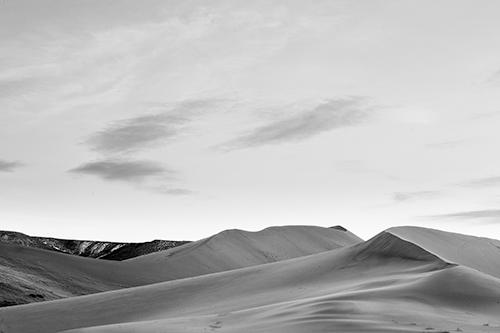I was visiting with another photographer one day and we were talking about quality of light. I rise early and stay up late to photograph during the sweet light hours. This other photographer mentioned that you need the sweet light for color photography, but then switch to black and white during mid-day. I was very surprised to hear him say that and I one hundred percent disagree with him. Light quality is just that, quality. It really does not matter if you are shooting color or black and white. If you want quality light, you must work when the light is good. I have always taught my students that if you learn to shoot black and white, your color work will be much better, due to the fact that you must learn to see tones. Good tonal separation happens when the light is good. That is just another reason to photograph early and late.
The image above was made just as the sun was setting at Bruneau Dunes. The low sun is what is creating the highlight and shadows that sculpt the shape of the dunes. There is also balance between the dunes and the sky. None of this would have happened earlier in the day. For great landscape photography it is a must to photograph during the sweet light, otherwise you are just taking snapshots.
With the advent of digital photography, black and white photography is becoming a lost art. So many photographers just shoot a thousand images and then play with them on the computer to see what will look good as a monochrome image. It used to be, back in the days of film, that you would have to learn to see in black and white. We used filters to shift tones when we exposed the film, and then made additional adjustments in the development and printing stages to get the previsualized image on paper. Now we apply filters after the fact, and we get to watch the development in our “digital darkroom”… computer. It still seems so backward to me. Maybe I am just old school, but I believe that thinking before we press the shutter, like we used to do, will make us better photographers. Thinking more and shooting less is much more effective than the alternative. It will help put art back into our photographs.



Recent Comments